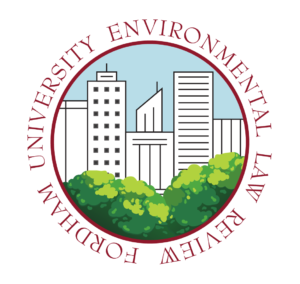Renewable Rikers
by Sarah Walsh, Fordham Environmental Law Review, Environmental Justice Columnist
In 2019, the New York City Council approved an $8 billion plan to close the Rikers Island jail complex and replace it with four smaller jails by 2026. However, rather than completely shut down and abandon the complex, the Renewable Rikers Campaign makes the case that the City should use the closure “as a moment for restorative environmental justice.”
Rikers Island, sometimes known as “the most notorious jail in America” and one of the world’s largest jails, has the capacity to house over 7,000 inmates. The majority of which come from New York City’s environmental justice communities (i.e., low-income and minority communities that are forced to bear an overwhelming and disproportionate amount of the hazards associated with climate change) . These include neighborhoods such as the Queensbridge Houses, Sunset Park, South Bronx, and the north shore of Staten Island – notably, communities that are home to peaker plants (polluting power facilities that only activate whenever the City’s energy demand increases and when air pollution is typically at its worst). Peaker plants “spew even more harmful emissions into neighborhoods already overburdened by pollution and exacerbating widespread health problem”. These communities are also home to most of the City’s wastewater treatment plants, bus depots, and municipal waste transfer stations.
The Renewable Rikers Act, proposed in January 2019 by City Council Member Costa Constantinides (whose district includes Rikers) would “create a sustainability hub on the site of the former prison.” The Act is composed of three bills, the most central of which transfers control of the island from the New York City Department of Correction to the New York City Department of Environmental Protection. The second bill requires the City to determine renewable energy capacity on the island and the third assesses how much waste wastewater can be diverted to the island – potentially closing several facilities in northern Queens, the South Bronx, and Upper Manhattan.
The Act mainly aims to use the complex for energy generation and waste management. However, due to the island’s relatively small size, it can’t host enough solar panels to generate sufficient energy. As such, the focus will be on storing power in batteries that can then be sent to the electrical grid when demand arises. The City would then be able to close down plants that are polluting communities in the outer boroughs.
Perhaps one of the biggest sells is the fact that the Renewable Rikers Act can help to address New York City’s environmental justice issues. As Constantinides’ partner on the bill, Rebecca Bratspies, the founding Director of CUNY Law School’s Center for Urban Environmental Reform, argues, it could be part of a reparative environmental justice process: “we can use renewable energy generation to remove the polluting infrastructure that was forced on some of the poorest communities in the city who are also most impacted by incarceration on Rikers.”

